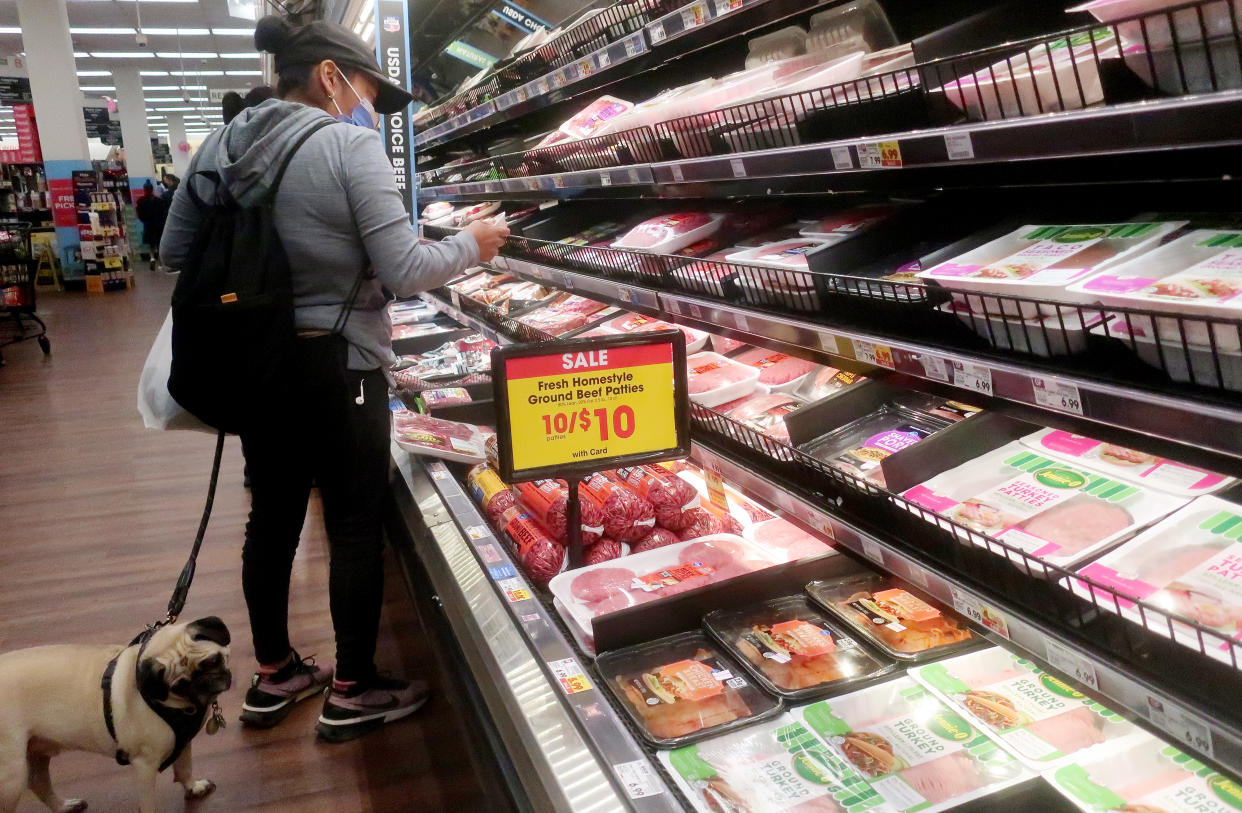Inflation: Grocery prices are back up (slightly), beef prices jump
Grocery prices had been cooling, then came July.
The cost of food at home — what consumers see at their local supermarkets such as Kroger (KR), Albertsons (ACI), and others — increased slightly in July after remaining mostly flat in recent months.
Grocery prices increased by 0.3% on a monthly basis, according to the Bureau of Labor Statistics' (BLS) Consumer Price Index (CPI) released Thursday. On a year-over-year basis, food-at-home inflation rose 3.6%, a slower rate than the month prior.
Overall, consumer prices were up by 3.2% in July over the prior year and 0.2% month over month.
The beef and veal category, which rose 2.4%, was one of the biggest drivers of the month-over-month increase. The category saw the largest jump since September 2021, BLS economist Steve Reed told Yahoo Finance.

Uncooked beef roasts led that monthly jump with a 6.5% increase from June to July. Beef steaks were up 2.3%, while other cuts of beef and veal were up 3.6%.
What's behind the jump? According to Wells Fargo agricultural economist Michael Swanson, higher beef prices stem from "the aftermath of one of the worst droughts we've had in the Southwest [last year] and a sell-off of all the cattle."
Essentially when a drought happens, producers sell off cows at once, which makes beef cheap. Now, as ranchers rebuild their herds, higher feed prices are costing them more and driving up prices overall.
The corn bushels for cattle feed currently stand at roughly $7 a bushel, Swanson said. That's compared to the $5 bushel expected after the next harvest.
Egg prices continue dropping
With high feed prices, it's a similar story for eggs.
Egg prices continued to decline, dropping 2.2% on a monthly basis and 13.7% year over year.
However, given that the price of corn feed for chickens is higher, like the cattle, it's keeping egg prices higher.
It takes about "three months, six months, nine months for that to run through the system and really see that competition come back," Swanson said.
Egg producers likely won't see relief in feed prices this month. Harvesting for this year's corn crop is set to begin in early September and then be completed by late October. That's when consumers will likely reap the benefits.
The good news, Swanson added, is that "we have not seen any avian flu," which was the cause for the unbelievable 70% year-over-year rise in egg prices Americans saw in January.
Cheaper chicken
Another bright spot in the report: Fresh whole chicken prices were down 2.1% in July compared to the prior month. According to BLS's Reed, that's the largest decline since September 2020.
Overseas competition drove that decline, Swanson said.
"We're getting competition from Brazil and Russia, so about 20% of chicken gets exported ... and most of it goes to like Mexico and other markets," He said. "So the United States is having to match those lower prices from some of those other markets. That global competition is hurting the poultry market."
Comparing apples and oranges
Some fresh fruit prices also ticked higher in July.
Apples jumped 2.4% in price last month, largely due to labor, input, and energy costs, Brad Rubin of Wells Fargo said.
"For apples, declining acreage and yield trends coupled with rising costs for labor, inputs, and storage (energy costs) have been factors for upward price pressure on apples," Rubin said.
Citrus fruits also saw a 1.7% rise over last month after a short crop in California affected supply.
"In the summer months, tangerines/mandarins are imported to provide year-round supply," Rubin added. "Less supply equates to higher prices."
That's expected to hit the juice aisle too.
"For juice products, Florida experienced the lowest production year on record from adverse weather and disease," Rubin said. "Juice processors have looked to import juice and concentrate to supply product."
Sweets and ice cream prices up slightly
With Halloween around the corner, consumers could pay more for candy and other treats.
Prices for sugar and sweets jumped 0.2% month over month. Compared to last year, prices have jumped 8.9%.
Swanson said the jump in price likely has to do with "drought in a couple of the key sugar beet areas" such as North Dakota, Northern Minnesota, and Idaho. "So that crop was very short, and we had to go to the global market" and places like Mexico to fill the gap.
While the US is expected to have a "better sugar harvest this year," he said, "we're a year away from getting completely healed up" in the key markets mentioned above.
That and transportation costs dragged ice cream prices higher too, up 1.5% on a monthly basis, Swanson said.
As we look to 2024, overall grocery prices are expected to decelerate but not decline next year. An outlook from the USDA forecasts grocery prices will increase 0.9%, with a prediction range of -6.8% to 9.3%.
More Yahoo Finance inflation coverage:
Stocks climb as inflation ticks up but trends stay positive: Stock market news today
Inflation: Consumer prices rise 3.2% in July as inflation slowdown stalls
San Francisco Fed’s Daly: 'There’s still more work to do' on inflation
July inflation data shows 'convincing' signs price pressures easing, taking heat off Fed
July CPI report: Monthly inflation falls in line with estimates, rises by 0.2%
Inflation moderating, Disney earnings, Alibaba revenue: 3 Things
—
Brooke DiPalma is a reporter for Yahoo Finance. Follow her on Twitter at @BrookeDiPalma or email her at bdipalma@yahoofinance.com.
Read the latest financial and business news from Yahoo Finance
